China’s 2-D youth have embraced Japanese anime culture and are quietly building their own universe as far removed as possible from the grind of daily life
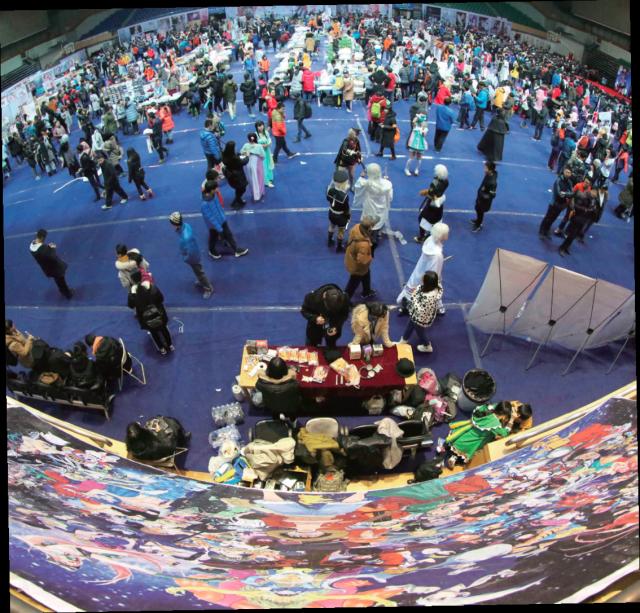
2-D youths gather at a comic convention in Qinhuangdao, Hebei Province, January 30, 2016
Clad in a navy blue sailor suit with a blue denim collar, a red neckerchief and a miniskirt, Junjun, a passionate cosplayer, has spared no expense in completing her transformation into the Japanese manga character Sailor Moon.
Her idiosyncratic costume, purchased online for over 300 yuan (US$46), was not selected as daywear for a comic book convention.
In fact, Junjun was on her way to a concert when approached by our reporter.
She did not feel the slightest bit embarrassed about walking on the street in full cosplay – in fact, she seemed completely at ease with the curious stares of passersby.
Junjun proudly identifies herself as “2-D.” The term is lifted from the Japanese ni jigen, literally “second dimension,” but in pop culture it is a reference to the virtual universes of anime, comics, video games and comic novels (ACGN). Those who define themselves as 2-D do so to differentiate themselves from the “3-D” or real world.
While the 2-D phenomenon originated in Japan, it has spread far beyond to influence youth cultures the world over, particularly in Korea and, more recently, China. According to data from a research report conducted by consultancy iResearch, the number of Chinese who could be defined as 2-D consumers was about 219 million in 2015. Of 59 million so-called “core users,” 95 percent were born after 1990, when imported cultural products from the rest of Asia began to become available in China on a massive scale.
These young people regularly read manga, watch anime, play video games, listen to ACGN music, participate in cosplay and religiously attend anime conventions. They form online groups through social media platforms and rally around “bullet screen” video-sharing websites that shoot viewers’ comments across the screen in real time so
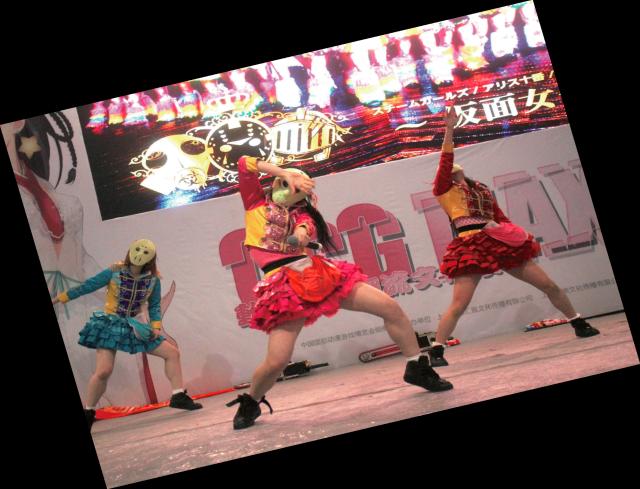
“Masked Girls,” a Japanese girl group, perform at the 2016 CCG MAX convention in Shanghai
they can instantaneously trade barbs and jokes concerning their beloved subculture.
Indeed, “subculture” is an increasingly redundant term to apply to China’s 2-D community, given that there is little alternative competition in the cultural sphere, particularly in the field of material aimed at teenagers and young adults. For those who identify as 2-D, the label goes beyond consumption; it is a badge that marks a complex culture with its own values, lifestyle, freedom and patois. By choosing to withdraw from the 3-D world, the 2-D feel empowered to build a utopia that offers the freedom to pursue passion, solace and selfactualization.
Boom In her 3-D life, Junjun is a fourth-year student in the sociology department of Renmin University. The wall beside her bed in her six-person dorm room is covered with posters of cosplayers, a photograph of a teenage pop star, and a banner reading “Pro-gay, antidiscrimination.” Junjun is already determined to focus her graduation thesis on the topic of moe, a philosophical branch of 2-D culture.
Junjun still fondly remembers her first cosplay convention. She dressed as Sailor Moon on that day, too, with her hair in long braids, but soon felt upstaged by the far more elaborate costumes of the more seasoned cosplayers. The convention’s boisterous “carnival parade” marched down the street, stopping traffic in a country where parades are, understandably, few and far between.
Junjun’s own group of cosplayers soon joined forces with over 2,000 more from all over campus. The surreal scene, with vividly recreated characters from dozens of comics, TV shows, movies and games all chatting in a shared space, enraptured Junjun. “It had a sense of ritual,” she told NewsChina. “As if it were performance art.” Despite earning disapproving glances or comments from 3-D passersby, cosplayers are accustomed to being outsiders, and remain unfazed.
“Let them stare,” said Junjun. “We don’t care. I think the most precious quality of 2-D people is our absolute individualism.
We are living in our own world.
We never feel bothered by the opinions of others.” J a p a n e s e ACGN material, imported into the Chinese mainland at the end of the 20th century as the marketplace opened up, quickly earned a wide following, helped along by legions of lifelong fans in Taiwan, Hong Kong and Macau. In Japan, and more recently in the West, enthusiastic ACGN lovers are usually called otaku, a Japanese word loosely equivalent to “geek” or “nerd,” that signifies a passion for ACGN that borders on obsession.
In China, the term otaku has traditionally been pejorative, and applies to young people viewed as antisocial and kooky – traits that most ACGN lovers argue they do not possess. Thus, they eschew the otaku moniker, and embrace the term 2-D, describing themselves as “2-D creatures.” The core characteristics of the 2-D generation are a fanaticism and exceptional depth of knowledge of their preferred media. Individuals strive to exploit every avenue to obtain the latest information and acquire the most desired and rare products, and, unlike more socially withdrawn subcultures, they are not shy about exhibiting their passion for individual series and characters.
It is this passion that is termed moe, and, for those who experience it, is a profound and emotional state of mind. “[Moe] is a tingling sensation
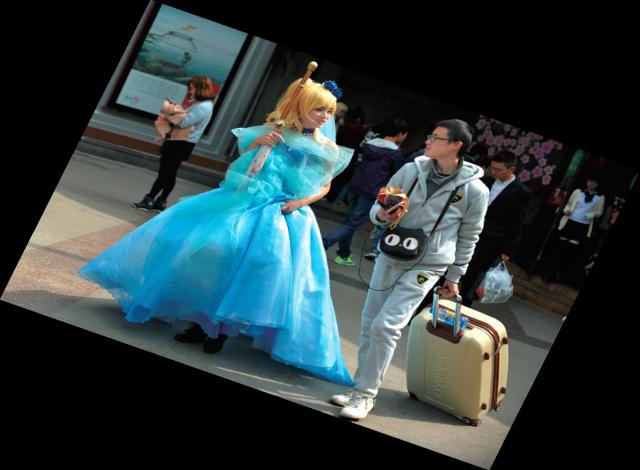
A cosplayer attracts the attention of a passerby during a comic convention in Wuhan, February 28, 2016
that runs through the bones like a surge of electricity,” said one 26-year-old ACGN fan we spoke to who goes by the handle Bluecat. “I get a burning feeling of happiness whenever I see my favorite character or production.” China’s 2-D boom coincided with the advent of the Internet age and new media.
As digital technology matured, became mainstream and finally ubiquitous, China’s 2-D subculture found itself in a golden age.
Practically born tech-savvy, and often confined to their rooms by an exam-oriented academic culture, the 2-D generation can easily use their smartphones to access anime, buy comics, games, action figures, cosplay outfits – any of the merchandise associated with their life’s passion. Another major boon has been the profusion of online platforms that provide a means to organize various online or offline activities.
Many agree that the 2-D subculture is rooted in exclusivity, and exists and thrives on its members viewing themselves in opposition to the 3-D world. The 2-D community even has a word for the invisible boundary between the two realms – the “Dimension Wall,” a barrier they view as being very difficult to cross. In the 2-D world, a selfregulating virtual state, people speak with a particular vernacular incomprehensible to outsiders, rich with inside jokes, slang and jargon derived from ACGN arcana, reinforcing the sense of identity and belonging among 2-D youth.
Various reasons underlie the particularly huge ACGN market in China. The Internet has a high penetration rate among teens and youths, and poor enforcement of copyright protection makes premium material easy and cheap to access.
A highly competitive, exam-oriented education system (which keeps most youngsters either at home or in class for most of the day), high academic expectations of parents, and a generally pragmatic and utilitarian approach to work and personal development adopted by parents, schools and society as a whole make escape into an online universe relatively free of such pressures – an essential release for many.
Moreover, China’s domestic ACGN industry is poorly developed in comparison to the entertainment industries of Japan and the US. Members of China’s older generation still view ACGN as cartoons aimed at children, as most domestic animation, such as 3000 Whys of Blue Cat and Pleasant Goat and Big Big Wolf, is designed for preschoolers. Domestic TV dramas and films aimed at adults, meanwhile, tend to echo reality, whether in soap operas or historical dramas. These genres are of limited appeal to teens and young adults who can find a wealth of rich, imported entertainment options, from the latest Japanese anime releases to Game of Thrones, available to stream for free online. In short, 2-D culture caters to a market that is not served by the domestic cultural sector.
Duality Junjun’s description of the 2-D lifestyle is succinct. To her, it means “living different lives in different worlds. Talking with different people in different ways.” She added that it is her belief that a certain degree of ease with duality “is a basic skill that every 2-D community member will possess.” Constantly switching between the 2-D and 3-D realms is a vital survival technique for Junjun and her peers. Maintaining multiple identities and personalities while straddling two dimensions is both a challenge and a reward, though many 2-D youth conceal their alternate identities when moving in the real world.
In the foreword to social researcher Yi Qianliang’s book Otaku: the Mania of the 2-D World, academic Ma Zhonghong states that “the virtuality and anonymity of cyberspace gives teens and young people much more freedom to fully express themselves, further explore their talents and discover richer layers to their personalities and identities.” In the 3-D world, Horo is a 22-year-old fourth-year computer science student at Hunan University, currently interning with a local IT firm. Tall and rangy, Horo is not fond of sports, despite his parents encouraging him to play basketball. He does not have a girlfriend,but, unlike many of his classmates, is unfazed by his single status. He never smokes, seldom drinks, is generally taciturn and rarely engages in horseplay with his friends. In his words, Horo was never one of the “cool kids.” In the 2-D realm, however, Horo lives a very different life. When asked about his “other” existence, his face lights up, eyes twinkling, and he delights in talking at length and with consummate wit, albeit employing language alien to the 3-D masses.
“I am a typical Lolicon otaku,” Horo grinned, referring to “Lolitas,” idealized underage girls that are a mainstay of manga culture. Horo has a long list of beloved “Lolis,” and a wide collection of figurines and pillows printed with their images that he picks up at anime conventions.
Horo’s bedroom looks like an artist’s impression of a typical otaku living space – the shelves are lined with Loli figurines, comic books and magazines, model kits, and his number one conversation piece – a mounted steel katana.
Horo’s dream woman, he told NewsChina, is Sabor, a female incarnation of King Arthur and the protagonist of the video game “Fate/ stay night.” The character’s unearthly beauty, courage, loyalty and integrity have enchanted him so deeply that Horo is concerned no real-world woman will ever measure up. “2-D girls are perfect” he said. “I’m afraid I will never find such an ideal girl in the 3-D world.” Creativity Many 2-D youths are not only cultural consumers, but producers in their own right. According to the iResearch report, 30 percent of 2-D consumers are also authors and artists generating fan fiction, fan art, and musical and video tributes to their favorite characters and

Xianxian, a professional cosplayer from Chengdu, removes his makeup after a performance
series. The process of creating content further entrenches a sense of investment and participation in a meaningful community, something many 2-D youth claim is hard to find in the 3-D world.
Horo once wrote a 200,000- word online fan fiction novel, Love in the 2-D World, featuring a Loli girl as its main character.
The response from fans, and the ability to self-publish online, gave Horo a deep sense of fulfillment, and he relished the opportunity to communicate with his readership.
Junjun, who admits she is similarly solitary in the real world and “not good at dealing with people,” is a very popular online singer-songwriter who has uploaded over 100 songs celebrating her beloved series and characters on various video-streaming websites.
As many as 200 people have collaborated on Junjun’s tributes, including composers, songwriters, mixers, video editors and graphic designers. “When the song is finally released, you will find that you are a part of it. It feels so great to create a collective work,” she told NewsChina.
In Otaku: the Mania of the 2-D World, author Yi Qianliang aligns the nature and values of 2-D culture with ideas and theories of estheticism espoused by Oscar Wilde, to whom the quotation “Life imitates art far more than art imitates life” is attributed. Yi finds that 2-D youth have very similar existential views.
“In the eyes of 2-D people,” Yi writes, “the 2-D world is a world of art, a world of beauty, that is more real than reality. Their 3-D life is an imitation of the 2-D world. Their modes of dress, choices made in terms of interior decor, their collections [of merchandise], speech, lifestyles and even values all imitate the 2-D world. Thus, for them, the virtual 2-D world is foremost, and the 3-D world secondary.” “I am an idealistic person,” cosplayer Debris told our reporter.
Debris’ favorite anime and manga are rooted in social commentary.
“Many comics feature the eradication of injustices that are prevalent in reality,” he continued. “Protagonists in manga are courageous enough to fight against injustice, but few people in real life have the same capability or bravery to stand in opposition to unfairness. Thus, rather than place our hope in the 3-D world, many people turn to the 2-D virtual world to find peace and comfort.” Female ACGN lovers view the 2-D world as a place of chivalry, empowerment and both romantic purity and erotic perfection. The yaoi and shonen’ai, or “Boy’s Love” (BL), genres, for example, featuring romantic and often explicitly sexual relationships between idealized male characters, are particularly popular among women, with fans terming themselves “rotten girls.” Instead of realistically d e p i c t i n g the lives of gay or bisexual men, BL works present an i d e a l i s t i c fantasy of romantic love between males that resonates most strongly with women.
Bluecat, a self-described “hardcore rotten girl” for 12 years, has an extremely deep understanding of yaoi culture and the thought processes of yaoi fans. In the eyes of many rotten girls, Bluecat told our reporter, opposite sex relationships are rooted in social convention and status. Same-sex romance, which in much of Asia remains taboo, is “purer and fiercer” because such pairings, like 2-D culture itself, fly in the face of social expectation.
“Yaoi gives many young women a spiritual shelter in which love for love’s sake, not marriage or childbirth, is uppermost,” Bluecat told our reporter. “True love can transcend gender boundaries and shatter moral, ethical and cultural norms. We know that such love can seldom be found in reality, but it does not mean that we cannot pursue it in our imaginations.” The idealism inherent in 2-D cultural products has led some to stereotype aficionados as infantile and suffering from a collective Peter Pan complex. 2-D youths refute such claims. “Choosing a 2-D lifestyle is not equivalent to isolating oneself,” said Debris. “It is the way I choose to communicate with the world.” Individualistic, creative, diverse and entertaining, 2-D culture has shaped a generation’s sense of identity, lifestyle and values as well as a sense of community in a way that other cultural products in China, tainted in the eyes of many by excessive conservatism and heavyhanded censorship, simply cannot. Despite this, there are few 2-D fans aged over 30, and most will freely admit that, eventually, they expect to fully rejoin the 3-D realm.
“I know one day maybe I will withdraw a little from the 2-D world,” said Horo. “But for my whole life? I can’t separate completely from my old friend.” “If one day I have a child, I will definitely introduce him to the 2-D world and say, ‘See what a fantastic world your dad was living in!’”
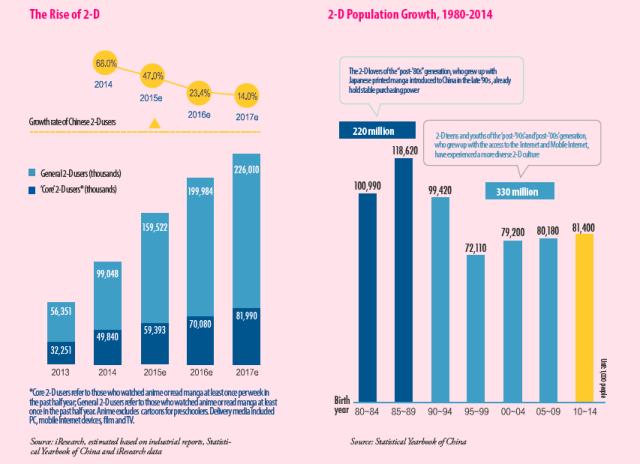
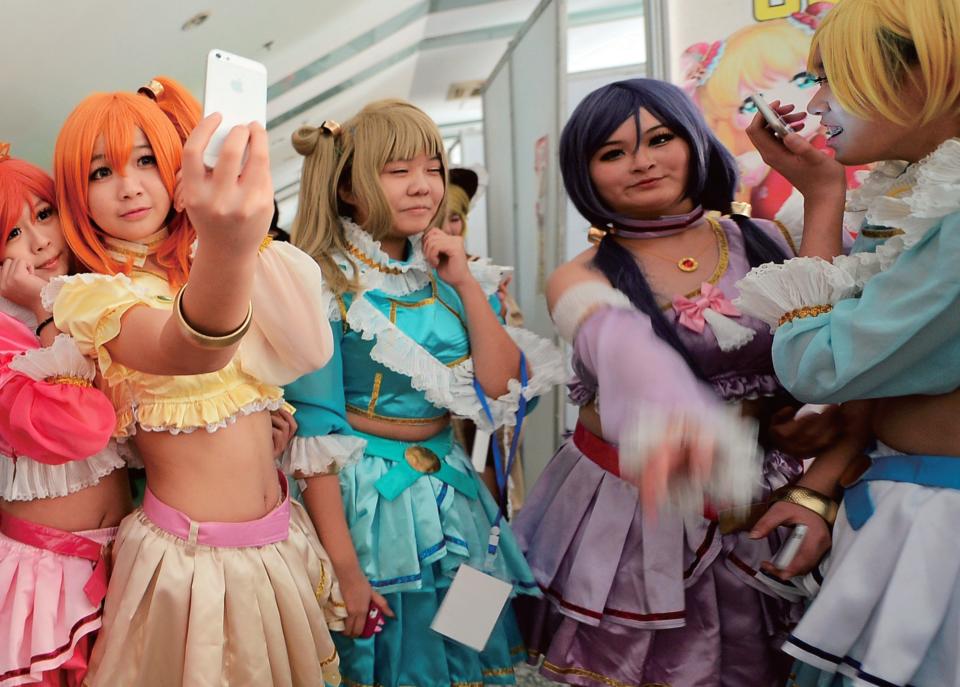
 Old Version
Old Version




